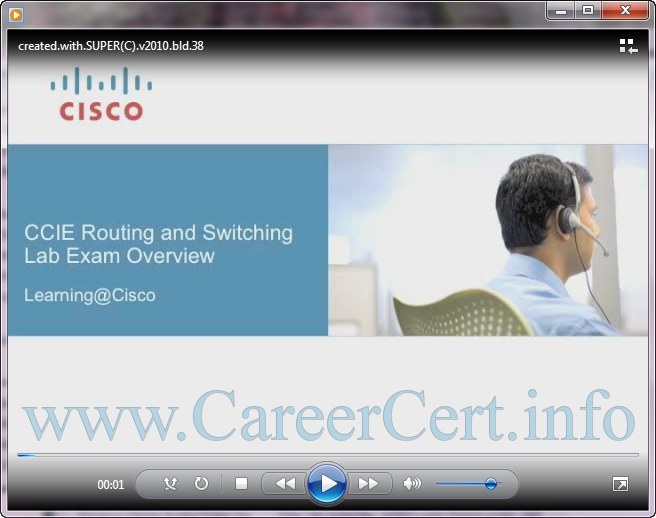Cisco 360 Learning Program for CCIE R&S - Lesson Troubleshooting | 2.9 GB
The centerpiece of this Lesson Module is the Troubleshooting video on demand (VoD) instruction. The split-screen format of each VoD module provides the powerful learning experience of shadowing a Cisco CCIE who is configuring and explaining a Troubleshooting process.
Duration
Seven Hours
Each VoD is approximately 15 30 minutes in length, and the approximately seven hours of VoD modules are grouped into three blocks. A set of supporting "Spot the Issues" soft assessment quizzes are included in each block. In addition, two hands-on, technology-focused practice labs on the subject of the Troubleshooting are available in this Lesson Module.
Target Audience
The Troubleshooting lesson is for professional-level networking engineers who have 3 5 years of network engineering experience or who have completed the Cisco CCNP certification. This self-paced Lesson Module is for engineers who need to master CCIE-level problems that involve:
* Formulating a structured and consistent troubleshooting process
* Troubleshooting Link-Layer Technologies
* Troubleshooting IPv4 Routing Protocols
* Troubleshooting IP Services: IPv6, Multicast, Router QoS and NAT
Recommended Prerequisites and Corequisites
A CCNP level of understanding of network troubleshooting are required. It is also recommended that this lesson be completed with these lessons
* CCIE R&S Lesson: Data Link Layer Technologies
* CCIE R&S Lesson: Frame Relay
* CCIE R&S Lesson: BGP Routing Protocols
Lesson Module Objectives
Upon completion of this self-paced Lesson Module, learners should be able to formulate well-defined mental simulations to perform the following Troubleshooting tasks with the minimally described parameters that are commonly found in CCIE-level tasks.
* Formulate an end-to-end opening moves strategy for troubleshooting tasks
* Formulate a troubleshooting strategy for link-layer technologies
* Formulate a troubleshooting strategy for routing protocols
* Formulate a troubleshooting strategy for IP Services that include IPv6, Multicast, Router QoS and NAT
Lesson Module Outline
The VoDs in this Lesson Module discuss these topics:
* Block 1: Troubleshooting Tools and Techniques Introduction to Troubleshooting
* Troubleshooting Tools IOS SHOW Commands
* Troubleshooting Tools - PING
* Troubleshooting Tools - Traceroute
* Troubleshooting Tools Debug IP Packet Part I
* Troubleshooting Tools Debug IP Packet Part II
* Troubleshooting Frame-Relay Part I
* Troubleshooting Frame-Relay Part II
* Troubleshooting Frame-Relay Part III
* Troubleshooting Switched Interfaces Fundamentals
* Troubleshooting Switched Interfaces Strategy Part I
* Troubleshooting Switched Interfaces Strategy Part II
* Block 2: Troubleshooting Routing Protocols Troubleshooting RIP
* Troubleshooting EIGRP Adjacencies
* Troubleshooting EIGRP Routing
* Troubleshooting OSPF Adjacencies
* Troubleshooting OSPF Routing Part I
* Troubleshooting OSPF Routing Part II
* Troubleshooting Redistribution
* Troubleshooting BGP Neighbor Relationships Part I
* Troubleshooting BGP Neighbor Relationships Part II
* Troubleshooting BGP Routing Part I
* Troubleshooting BGP Routing Part II
* Troubleshooting BGP Filtering Part I
* Troubleshooting BGP Filtering Part II
* Troubleshooting BGP Filtering Part III
* Block 3: Troubleshooting IP Services Troubleshooting IPv6 Part I
* Troubleshooting IPv6 Part II
* Troubleshooting IP Multicast
* Troubleshooting Router QoS Part I
* Troubleshooting Router QoS Part II
* Troubleshooting NAT
Lab Outline
This Lesson Module contains two hands-on labs that focus on the Troubleshooting topics in the VoDs. Learners must supply the lab equipment that is required to run the labs. Each of these hands-on, technology-focused scenarios consists of:
* A scenario written with CCIE-level troubleshooting tasks
* A detailed Answer Key
* The web-based and highly interactive Mentor Guide
Lab Topology
The following minimal topology is required to perform the Troubleshooting Lesson Module labs.
 Comments (0)
All
Comments (0)
All










